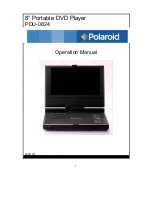
20
OPM-134/B
CAUTION: PERSONAL INJURY
Only change fuel filter when the engine is not
running and is at a low temperature in order to avoid
the risk of burns.
1. Remove the filter by unscrewing it.
2. Damp the new filter seal with diesel or engine oil.
3. Hand screw the new filter into place until the seal
gasket touches the support, then lock by a further 3/4
of a turn.
FILLING COOLANT
CAUTION: PERSONAL INJURY
Only fill coolant when the engine is not running and
is at a low temperature in order to avoid the risk of
burns.
CAUTION: EQUIPMENT DAMAGE
Never use a cold coolant mixture to top up the
radiator of a hot engine if the coolant level is very
low; this could cause serious engine damage.
1. Ensure the radiator plug located at the bottom of the
radiator and the plug on the engine block are secure.
2. Remove the cap and slowly pour the coolant into
the radiator until it is even with the lip of the filler port.
Ensure no air bubbles develop.
3. Reinstall radiator cap.
CHANGING COOLANT
Engine coolant contaminated with rust or water scale
reduces the cooling effect. Even when extended life
engine coolant is properly mixed, the engine coolant gets
contaminated as its ingredients deteriorate. Drain, flush and
refill the cooling system with new coolant every 1200 hours
or every 2 years, whichever comes first.
CAUTION: PERSONAL INJURY
Only proceed when the engine is not running and
is at a low temperature in order to avoid the risk of
burns.
1. Loosen the seal elements, remove the sleeves
connecting the engine circuit to the heat exchanger
and wait until it has emptied completely. When empty,
repair the circuit making sure that the sleeves are
Filter
perfectly
sealed
2. Refill the engine and the heat exchanger until
complete
top-off.
3. With the filler cap open, start the engine and keep it
idling for nearly one minute. This phase facilitates the
cooling liquid air bleed.
4. Stop the engine and top up again.
5. Dispose of coolant in accordance to local codes. DO
NOT dispose or allow oil to seep into the ground or
sewer systems, doing so will cause environmental
damage.
CLEANING RADIATOR
The surfaces of the radiator come into contact with the
outside air and can be subject to deposits and impurities.
Clean in accordance to the maintenance schedule with
compressed air or steam.
1. Check that the radiator air inlets are free from dirt (dust,
mud, straw, etc.).
2. Clean them if necessary, using compressed air or
steam.
CHANGING AIR FILTER
The engine performance is adversely affected when
the air cleaner element is clogged with dust.
WARNING: EQUIPMENT DAMAGE
Never operate the engine with the air cleaner
element removed. This may allow foreign material to
enter the engine and damage it. Do NOT remove filter
while engine is running.
WARNING: EQUIPMENT DAMAGE
Take care to ensure that the parts are reassembled
correctly. Imperfect assembly might result in
unfiltered air being sucked into the engine, causing
serious damage.
1. Remove the filter cover after first unscrewing the
locking
handle.
2. Remove the external cartridge, after unfastening the
second locking handle; during this operation, take care
to ensure that no dust gets into the sleeve.
3. Check that there is no dirt. If there is, clean the filter
element. Blow dry compressed air through the filter
Filter cover
Filter
element
External
cartridge









































